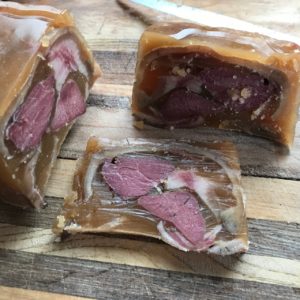
Headcheese
A Delicious Way to Boost Your Antioxidant System
Instructions
- Butcher the pigs heads, removing the jowls, cheeks, ears and snouts separately. Set the jowls aside for bacon or jowl confit.
- Brine the cheeks, ears and snouts by adding 2% Morton's tenderquick by weight. That works out to 9g of cure or 1 tbsp per lb. Rub the cure evenly over the parts and refrigerate overnight.
- Cover the pug heads with water in a large pot. Bring to a boil, cover and reduce to a simmer for 8-12 hours.
- The next morning, strain the liquid from the heads, reserving all of the liquid. If it is very reduced, you should add some water and make sure the broth is rinsed off the bones before straining.
- Strain the fat from the top of the broth. You can do this with a ladle or a fat strainer, just like making gravy. Or you can refrigerate the broth overnight. The fat will solidify on top and you can simply scrape it off.
- Add the strained liquid to a large pot and bring to a simmer.
- Put a small amount of the broth into a ramekin, jar or bowl in the fridge to solidify. This is a test for firmness. The final product needs to be firm enough to slice with a knife when it comes out of the refrigerator.
- Make a boquet garni with a clean rag or some cheesecloth. Add to the cloth aromatic spices - black peppercorns, cloves, juniper berries, bay leaves, cinnamon, allspice berries, oregano, rosemary, orange peel, rose hips. You can get as creative as you want here, but you can do worse than to simply use a commercial pickling spice, which is what I did. Tie the boquet garni closed with kitchen twine ans add it to the simmering liquid.
- Trim any remaining membranes from the cheeks, tongues, etc. Remove any hard cartilage from the snouts.
- Simmer the cheeks, snouts tongues and ears in the broth for 2-3 hours, until the cheeks will easily pull apart with a fork. You can weigh the top of them down with a heavy ceramic plate to keep them submerged. The gelatin from the ears and snouts that cook out during this step will continue to thicken the broth.
- If your test broth that you refrigerated is sufficiently firm, you can go ahead with the recipe. It should be as firm or ideally a little firmer than commercial Jello. If its not, make a new test block now that you've simmered the ears. If your block is very soft, you may need to reduce the volume of liquid by reducing it. Measure the volume of the liquid and then boil the water away until taking test blocks as you go, until you get a consistency you like. If you go too far, you can always add back a little water.
- Once you're happy with the firmness, adjust the salt. You want it taste quite salty at this stage. Salt tastes more pronounced in hot foods than it does in cold foods. The headcheese has to be served cold so if it's a little too salty now, it should be perfect when served.
- If the membrane in the center of the ears is still too chewy, it should be easy to peel away either side of the ears and discard the membranes.
- Now line a baking pan with the ears, put the cheeks, tongues and snouts in the center, pour the gelatin over the pans and refrigerate overnight.
- Enjoy!